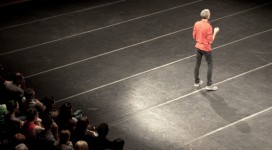blog_ 7x7
XAVIER LE ROY x LAURA BRUNO = the rite of remorse and projects.
by Laura Bruno from The Rite of Spring (A Sagração da Primavera) by Xavier Le Roy.
“For contemporary art the problem assumes from the start the form of aporia: what to do when everything has already been done? [p. 84]
In this mined terrain, saturatedly historic, there’s no place for the candid conscience. [p. 85]
The end of vanguards, the disbelief in the logic of the modern art history are now in evidence. [p. 112]
With the explosion of vanguards in the first decades of the century, the work of art became everything and anything. No theory ideal, no formal principle could define or qualify it a priori any longer. [p. 74]
To think the death of art, practice it, so to say, was the routine of the vanguards in the beginning of the century. [p. 76]
In the modern era, this was still done in great part in the immediate critical contact with the traditional artistic material, let’s say in loco – precisely where tradition was articulated. [p. 84]
Curiously enough, even symptomatically, little is said about the passage from modernity to contemporaneity. Perhaps unconsciously the later may pass to most people as mere decadence of the former. The great works would already have been done and only the task to exhaust the lines of modernist research would remain. [p. 80]
The contemporary question resists the inevitable formalistic attacks of academics. The several theoretical enterprises that wish to adequate the new procedures to the télos of art history bump, right from the start, into the “lack” of novelties, the impossibility to locate precise and undoubtedly a throw, a syntagma, with a positive degree of transformation. To a certain positivist accounting, artistic contemporaneity reminds a simple space of repetition.
[p. 81]
Everything seems a déjà vu, nothing has the direct power of the heterogeneous, the unthinkable subversive. The things of art do not point towards a clear direction of positivity or negativity – their processuality decides everything in that matter. [p. 86]
This deficient critical space, this polemic distance, vanguards have created by beats of lucid madness. [p. 77]
It should be reminded that, for a certain type of consumer, the mythic term vanguard offers an ultimate appeal. [p. 59]
And it is above all in relation to this ideology that in my view a contemporary work is defined: a proposal is more interesting when it presents a higher degree of freedom in the established art system. To force the limits of permissiveness in the circuit is one of the main tasks of contemporary production. [p. 60]
A calculation of reason, a non-stop brain activity passes constitutively through the several instances of contemporary art in the exact measure by which its place is sole and radically reflexive. [p. 85]
In this sense most of all the new art is doomed to reflection: it brings with itself, in the immediate formalization level, its own absurd, the doubt about itself. [p. 86]
However, there is no doubt that this type of action demands, among other things, that the artist, say, stop being an artist: to free himself from the myth of a “being who creates” – a position that grants him a comfortable yet useless situation – and to think about himself as someone who is fully committed with the current signification systems and processes in society. [p.60]
If there is anything that 120 years of modern art have taught, it is the relativity of “ruptures”, the strict logical sequence that governs and dimensions them. For good and bad, contemporaneity carries the burden of this conscience. [p. 112]
History has no end, as well as no beginning. History is an open process, it is a non-stop interpretation, it is remorse and project. [p. 147] ”
[BRITO, Ronaldo. Experiência Crítica. São Paulo: Cosac & Naify, 2005.]
Laura Bruno is a dance researcher and admires Ronaldo Brito’s critical experience very much.
Translation Portuguese-English: writer and poet Chris Ritchie, M.A.

